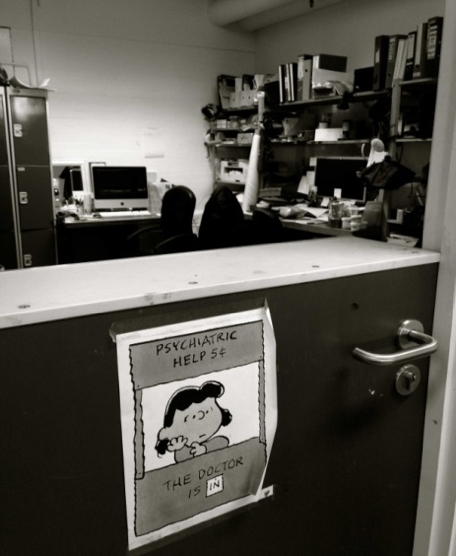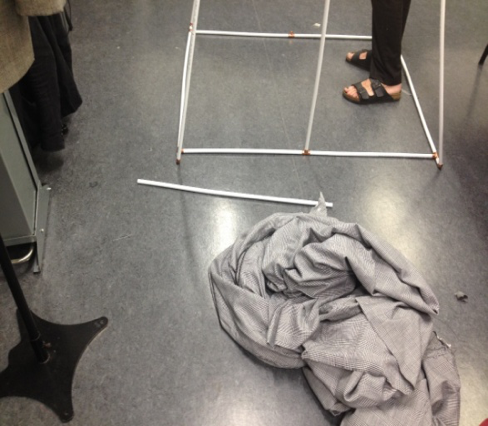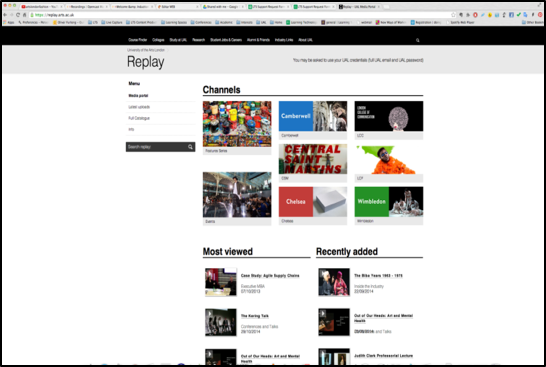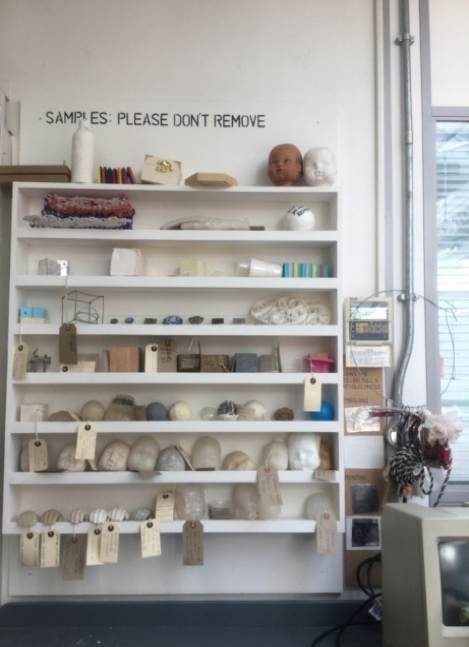How do art and design technicians conceive of their role in higher education?
Clare Sams, Artist (formerly a Technician at Central St Martins)
Abstract
This case study asks, what do art and design technicians do? As part of a research study technicians working across all four colleges of UAL were interviewed. The study used a mixed methods approach, involving a survey followed by participant produced images accompanied by text-based self-analysis in order to create a portrait of technicians’ views of their role in higher education. The study found that technicians perceive their role as supporting staff, students and events in both traditional and virtual learning environments, but also as educators, artists and expert practitioners within their specialist areas of art and design.
Keywords
technician, expertise, workshop, teaching, learning, students
Surveying the technician’s role
This descriptive case study (Gilham, 2000) explores the role of the technician in higher education, eliciting their views on what they do. The investigation was open to members of technical staff within all colleges of UAL. Bell (2010) suggests that when doing a research project like this, a more focused case study approach can identify features within organizations that are usually hidden by a large-scale study. As there is a lack of contemporary literature on the HE technicians’ role in art and design (Blythman et al, 2008), it was necessary in the first instance to gather an overview, in order to better understand the role. The initial phase of the research utilised an online survey made available to all technical staff within UAL. The survey gave participants an opportunity to reflect on their attitude towards their role. The survey was distributed to technical staff through the line managers for each college. Responses were received from all colleges, with an overall response rate of more than 10%.
Summary of survey responses
Technician 31 describes his/her role in terms of helping and supporting - a common participant response:
Helping students achieve their creative potential, supporting staff and students with technical queries, promoting sustainability and reuse of materials, balancing health and safety and creativity in a workshop environment. (Technician 31)
A technician’s role is complex and varied, offering technical support in a wide range of disciplines. Supporting students was highly important to most staff and many suggested that both teaching skills workshops and helping students through individual support were fundamental to their role.
Technical coordinators line manage the technical staff in their teams and support them in their roles and professional development. The importance of being responsible for health and safety seemed to resonate with all grades of technical staff, suggesting it is one of the core aspects of the role:
Managing a large technical team across diverse specialisms, I am responsible for all aspects of day-to-day operations within these areas: health and safety; staff management; timetables; resource management; strategic planning. (Technician 2)
Notably, many managerial staff discussed the process of working with students to a lesser extent. This trend links to those outlined by the findings a report on Highly skilled technicians in higher education (Smith et al, 2004), which indicates that many technicians move away from the traditional skills-based aspects of their role as they advance in their careers.
Staff support was an important factor in technicians’ descriptions of the tasks they undertake. For example, many technicians support events within the university, using their skills in printing or in-depth knowledge of AV equipment. Health and safety also featured strongly in the survey data, with technicians describing how they spend a lot of time maintaining this specialist equipment.
Students value and find the teaching provided by the technicians invaluable and essential to their learning and further practice. This is currently shown through the ‘White Square Teaching Awards’. (Technician 11)
Staff considered their delivery of learning in the form of skills and techniques to be an important aspect of their role. They felt that the university valued their skills, but most technical staff did not feel that they were well supported in their career and professional development. By contrast, those whose role involved managing other technicians did feel supported.
The majority of technicians who took part in the survey were also active arts practitioners, 40% of whom felt this practice was not valued by the university:
I recently decided to give more time to my arts practice because I don’t see any option for me at University. As a technician I have no chance in terms of career and no time at all for research, which is vital in my career. (Technician 21)
The fact that technicians maintain their arts practice in parallel to their technical role suggests they have a genuine enthusiasm for the arts.
The visual study
Although surveys can provide a broad view of phenomenon (Bell, 2010), Bent Flyvberg (2006) recommends using both qualitative and quantitative methods when undertaking social science based case study research. The use of two methods combines ‘rules based’ knowledge with ‘experiential’ knowledge and gives a fuller picture of the phenomenon. In order to provide such balance within this case study, the next stage used a more qualitative method.
Visual methodologies offer an accessible way for participants to express themselves in an indirect manner (Gourlay, 2010). As the technician’s role is an under-researched topic (Blythman et al, 2008), the next stage was sensitive to the needs of these staff as arts practitioners, and was therefore designed to encourage their participation. It used a method defined as ‘photovoice’ by Wang (1999), whereby participants collaborate with the project researcher to generate images, accompanied by text. In this case study, photographs were used as an initial talking point to encourage a discourse about the technical role. The images acted as a channel, or buffer, through which a more complex and deeper narrative might develop (Rose, 2007).
When technicians completed the initial online survey they were asked whether they were willing to take part in the second stage. From these volunteers 4 technicians were selected, one from each UAL college. They were asked to produce 3 images relating to student learning and the teaching aspects of their technical role. They were then asked to select one of these images and write a short accompanying analysis. The aim was to incorporate their voices into the study, and provide individual perspectives about technicians’ conceptions of what they do within art and design education. Wang developed a series of open questions to guide each text and a similar method was used to encourage the technicians, who were asked: ‘Why did you choose this image?’, ‘What is shown in the image?’ and ‘How does it relate to your role in learning and teaching?’. These questions were developed in part using the ‘photovoice’ method (Wang, 1999) and were also influenced by previous articles about technical staff (e.g. Hunt and Melrose, 2005; Smith et al, 2005; Vere, 2013).
Technician A
 Figure 1: photograph by Technician A (2015)
Figure 1: photograph by Technician A (2015)
‘There is always someone to talk to. A technician deals face-to-face not through emails, Moodle, Facebook or any other “online” tool.’ (Technician A)
Technician A chose this image into order to reveal a lesser-known aspect of the technical role, that of supporting students in a more holistic sense. The specific skills training and support provided by technicians are important, yet Technician A felt that the face-to-face interaction they provide is also of significant value to students.
Not only do students value contact hours, but in art and design direct interaction with staff is paramount to learning. Technicians play an important part in delivering this aspect of student experience. Technician A felt that whilst virtual learning environments have a useful role in education, face-to-face communication was more valuable for learning. As has been revealed in writings about professional recognition, this participant thinks it is important to be recognised professionally and valued for the work they do in supporting learning (Vere, 2013). Although Technician A felt that this support was highly valued by students, they did not feel a strong sense of value was shared by other academic staff teaching on the courses they support:
We are mainly valued by students constantly, but never from anyone else. The job of the technician is always backstage, as it should be, but it would be nice to be supported and valued. When I say valued, [that] means professionally valued, not just receiving the odd email saying “well done to all”. (Technician A)
Technician B
 Figure 2: photograph by Technician B (2015)
Figure 2: photograph by Technician B (2015)
‘It shows one approach of working one-to-one with individual students, taking the student through the process of an idea to realization. Challenging thinking, creativity and problem solving.’ (Technician B)
Technician B described the specific processes involved in creating a costume for a performance and the complex nature of design development. This process starts as a concept on paper or the computer screen and is then realised in the workshop. They describe how the costume is created as a prototype and how, in effect, all student work is a one-off creation, refined and remodelled until it suits the academic requirements:
The role demands a complexity of thinking and facilitating a huge range of students’ enquiries, using my expertise and knowledge, applied to a wide variety of different students’ approaches and individual ways of learning. (Technician B)
The idea that technical support is part of a much broader canon of knowledge and expertise reflects Hunt and Melrose’s definition of the theatre technician as a ‘master craftsperson’ (2005, p.70). This master of craft is confidently able to work through the creative process with students, combining traditional techniques, historical understanding and contemporary approaches to create diverse student outcomes.
Technician C
 Figure 3: image by Technician C (2015)
Figure 3: image by Technician C (2015)
‘Recording academic taught content in traditional lecture spaces, but we are particularly keen in ongoing research into capturing workshop orientated activity.’ (Technician C)
Technician C did not have a student-facing role. Their job involved creating ways for students and staff to access learning materials, by making virtual learning spaces that redefine classroom boundaries by exploring ‘live-capture’. Instead of simply recording events or lectures, Technician C was exploring how other aspects of technical learning can be captured to develop learning spaces that reflect the more hands-on approach to art and design education provided by technicians. Even though Technician C did not work in a conventional university workshop, their work acknowledged the importance of more traditional workshop learning:
Increasingly we are involved in live mixing and video streaming content, and this is an area we are keen to research and explore for UAL, as another way of reaching prospective students, and other international audiences. (Technician C)
Research is an important part of this technicians’ role. It broadens the reach of the University by creating access to a universal, virtual lecture theatre that promotes learning and teaching for current and prospective students. Technician C’s understanding of online technology represents a broadening of technicians’ roles in art and design that is also recognized by Macfarlane (2011) when he describes how academic practice has morphed in recent years.
Technician D
The idea that objects promote discussion connects with the rationale behind the use of the ‘photovoice’ methodology used in this study (Wang 1999). It also links with ideas discussed by Shreeve, Sims and Trowler (2010) on the importance of learning through materials in art and design higher education. A notion reinforced by Berger (2009) when he describes how tools or artefacts can only be understood through the knowledge and expertise created by their use. Technician D worked with colleagues who develop online access to information about skills and processes, but to them, this shelf of objects (see Figure 4 below) represented an offline version of this facility. In their view, the real physicality of artistic processes cannot be captured using virtual technologies: ‘…there is no substitute for seeing the real object compared to seeing things online’ (Technician D).
 Figure 4: photograph by Technician D (2015)
Figure 4: photograph by Technician D (2015)
‘It promotes discussion with the students and helps hugely with their understanding of materials and processes as they are free to handle them.’ (Technician D)
Conclusion: what is the art and design technicians’ conception of their role in higher education?
In the data provided during both stages of the study, technicians revealed that being ‘experts’ in their discipline was important to their identity. The definition of a technician as an expert who works with highly specialized equipment (Braddock, 1995) was a unifying factor in participant responses regardless of specialism or discipline. Technicians viewed themselves as the point of contact for students and staff when they needed technical advice or specialist expertise. It was integral to their conception of being a technician that they utilized this combination of expert knowledge and expertise in their role (Smith et al, 2004; Berger, 2009).
The majority of technicians who took part in the study actively pursue their artistic practice outside of their technical role and the university. This follows Shreeve, Sims, and Trowler’s findings (2009), which describe how other art and design higher education professionals, such as associate lecturers, commonly also work externally as arts practitioners. Many technicians working in art and design HE choose the technical pathway as a means to support and develop their practice (Smith et al, 2004). The skills and expertise that result from artistic practice are part of a technician’s identity, as teachers acting as exemplar professional practitioners. The different ways in which technicians view their role reflects the specificity of their expertise, broadly set within the boundaries of the specialist equipment they use.
Three key themes emerged when comparing the responses from this study, establishing notions of supporting, helping, and teaching as fundamental to the technician roles. These themes define aspects of the technician’s day-to-day work, whilst also describing specialist types of technicians.
Supporting
Many technicians who use their expert knowledge of tools or specialist equipment in supporting academic teaching in workshops and studios. Sometimes described as academic support technicians. These staff may prepare materials or equipment for the use of academic lecturers in their teaching practice, and may also be a point of contact for students in the absence of academic staff.
Helping
Some technicians use their specialist knowledge to create learning environments. These learning environment technicians assist at events, in lecture theatres, classrooms, and virtual learning environments to create the right conditions for student learning. Learning environment technicians also includes line managers who support technical staff though management and staff development, helping to deliver technical learning environments.
Teaching
This last definition describes those technicians who see their role as in higher education as teaching based. This aspect of a technician’s role uses their knowledge directly, to teach students how to use artefacts in their own creative practice. They perform what Smith describes as 'quasi-teaching' (2004, p.41) as a part of the regular duties of their role, facilitating learning as well as teaching, a role that could also be described as a technical lecturer.
Note
The technicians’ images and comments are presented with full permission of the individuals concerned.
References
Arthur, J., Waring, M., Coe, R. and Hedges, L.V. (2012) Research methods and methodologies in education. London: SAGE.
Bell, J. (2010) Doing your research project: a guide for first time researchers in education, health and social science. Berkshire: McGraw Hill.
Berger, A.A. (2009) What objects mean: an introduction to material culture. Walnut Creek, California: Left Coast Press.
Blythman, M., Parker, B. and Tiffin, S. (2008) ‘Forget the academic staff! The contribution to creative learning in practice of technical staff and equipment’, Enhancing curricula: using research and enquiry to inform student learning in the disciplines conference. Lycée Francais, New York, 3-4 April. Available at: https://www.researchgate.net/publication/241824242_Forget_the_academic_staff_The_contribution_to_creative_learning_in_practice_of_technical_staff_and_equipment (Accessed: 22 June 2016).
Braddock, D. (1995) ‘What is a technician?’, Occupational Outlook Quarterly, 39(1), p. 38.
Flyvbjerg, B. (2006) ‘Five misunderstandings about case-study research’, Qualitative Inquiry, 12(2), pp. 219-244, http://dx.doi.org/10.1177/1077800405284363.
Gillham, B. (2000) Case study research methods. London: Continuum.
Gourlay, L. (2010) ‘Multimodality, visual methodologies and higher education’ in Savin-Baden, M. and Howell Major, C. (eds.) New approaches to qualitative research, wisdom and uncertainty. London: Routledge. pp. 80-88.
Hunt, N. and Melrose, S. (2005) ‘Techne, technology, technician: the creative practices of the mastercraftsperson’ Performance Research: A journal of the performing Arts, 10(4), pp. 70-82, http://dx.doi.org/10.1080/13528165.2005.10871452.
Macfarlane, B. (2011) ‘The morphing of academic practice: unbundling and the rise of the para-academic’ Higher Education Quarterly. 65(1), pp. 59-73, http://dx.doi.org/10.1111/j.1468-2273.2010.00467.x.
Rose, G. (2007) Visual Methodologies: an introduction to the interpretation of visual materials. London: SAGE.
Shreeve, A. (2009) ‘ ‘I’d rather be seen as a practitioner, come in to teach my subject’: identity work in part-time art and design tutors’, International Journal of Art and Design Education, 28(2), pp. 151-159, http://dx.doi.org/10.1111/j.1476-8070.2009.01602.x.
Shreeve, A., Sims, E. and Trowler, P. (2010) ‘ ‘A kind of exchange’: learning from art and design teaching’, Higher Education Research and Development, 29(2), pp. 125-138, http://dx.doi.org/10.1080/07294360903384269.
Smith, D.N., Adams, J., Mount, D., Reeve, N. and Wilkinson, D. (2004) Highly skilled technicians in higher education: a report to HEFCE. Leeds: Evidence Ltd. Available from: https://www.sheffield.ac.uk/polopoly_fs/1.568318!/file/HEFCE_technicians_in_he_2004.pdf (Accessed: 22 June 2016).
Vere, K. (2013) ‘In defence of the university technician’, The Guardian, Higher Education Network, 2 August. Available at: http://www.theguardian.com/higher-education-network/blog/2013/aug/02/university-technician-teaching-research-development (Accessed: 22 June 2016).
Wang, C. (1999) ‘Photovoice: a participatory action research strategy applied to women’s health’, Journal of Women’s Health, 8(2), pp. 185-192. Available at: http://www.public.iastate.edu/~bestler/arts_based_articles/1999_wang_women_health_photovoice.pdf (Accessed 15 July 2016).
Biography
Clare Sams is an established artist, creating narrative works in textiles and other media. She is an experienced arts professional and holds a Masters degree in Academic Practice in Art, Design, and Communication from UAL. Clare works as an independent arts educator within museums, galleries, schools and colleges, including The Royal Academy, Kings College London and UAL. She was a technician at Central St Martins when she undertook this study.